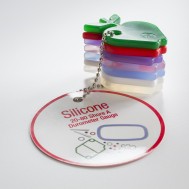Shore A hardness is a measurement that comes from a shore durometer tool. This tool is used to measure the hardness of rubber polymers and elastomers to indicate their resistance to indentation. Higher numbers on the scale mean greater hardness, while lower numbers indicate softer materials.
Shore A hardness is an important measurement to keep in mind when selecting a material for your o-ring. O-Rings are heavily impacted by their application environment, pressure and fluids, so it’s important to know the extent to which an o-ring will indent and change shape under certain conditions to avoid seal failure.
Here’s a closer look at the important factors of Shore A hardness that you need to know.
Testing for Durometer
An o-ring’s hardness is often referred to as its durometer because hardness is measured by a durometer gauge. There are three main categories of hardness:
- Shore 00: Measures rubbers and gels that are extremely soft, including gummy candy and gel inserts for shoes.
- Shore A: The most commonly used category providing a wider range of hardness. This scale measures flexible mold rubbers that range from very soft to exceptionally hard rubbers with almost no flexibility. Some semi-rigid plastics can also fall onto the higher end of the scale.
- Shore D: Includes hard rubbers, from moderate hardness to extremely hard. The Shore D scale also encompasses semi-rigid plastics to hard plastics.
- Type M: Described as a micro-hardness gauge. Type M is appropriate for measuring the hardness of specimens that cannot be accurately measured using the Shore A device. Type M durometer is intended for use on specimens having a minimum thickness of 0.050 inches, although it can be used on thinner specimens if there is data supporting the accuracy of the measurement.
There are several standard testing methods that exist for measuring rubber durometer. ASTM D-2240 and ISO 868 are two of the most common. These specifications typically account for rubbers falling in the range of 20 to 90 Shore A.
ASTM D-2240: This test method uses a tool that penetrates the rubber under specified conditions to measure the indentation. This procedure is used for determining the indentation of thermoplastic elastomers, vulcanized rubber, elastomeric materials, gel materials and some plastics.
ISO 868: This test measures the indentation resistance of plastics by means of two types: type A and type D. Type A is used for softer materials while type D for harder plastics. This method permits the measurement of initial indentation or indentation after a specified period of time to understand how the material may function in certain environments.
It’s important to note that a durometer scale will only measure hardness. Durometer will not predict abrasion resistance or the speed of wear. Additional testing must be done to account for these other factors.
Applying the Scale to Specific Applications
Every application requires a different level of hardness for sealing success. A rubber material must be soft enough to fill the gaps between two surfaces, but also hard enough to withstand loading forces without extrusion. For low pressure applications, lower hardness is recommended so that seals deform faster and don’t allow small leaks. Higher pressure applications use higher durometer to reduce the need of backup rings.
The low end of the Shore A hardness scale covers rubbers flexible enough for rubber bands and pencil erasers. These durometers would fall between 20 and 40 Shore A. Moderate Shore A hardness includes rubbers used for car tires and shoe heels, offering some flexibility but are relatively hard. These durometer scores would fall between 70 and 80 Shore A. Rubbers measured at the top of the scale are often very hard with no flexibility at all. For example, shopping cart wheels are typically measured at around 95 Shore A. The Shore A hardness scale is a useful tool for deciding the flexibility you need for your sealing application.
Want to learn more about Shore A Hardness of rubber materials?
Visit our Material Selection Guide for specific Shore A measurements for each material we use.
